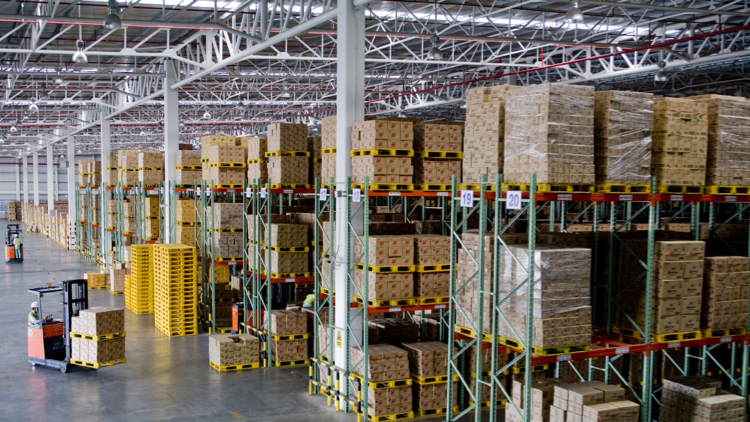When most people think of commercial real estate, their minds gravitate toward the types of properties they’re most familiar with: offices (where they work) and retail (where they shop). They’re usually not thinking of the industrial real estate where the goods they use are made and shipped from.
The foundation of that knowledge always starts with an understanding of the basics. Here’s our rundown of the eight most common types of industrial real estate.
Manufacturing
The word “manufacturing” evokes images of giant factories churning out products. And yes, that’s true on a basic level. Manufacturing sites are where goods are produced and assembled, and according to NAIOP, they tend to be less than 20% office space, have loading docks for trucks, and clear heights of at least 10 feet. But that leaves plenty of room for variation, as these properties change a lot based on their purpose. Here are the two most common buckets:
1. Heavy manufacturing
These giant plants tend to make heavy-duty goods and materials. They usually have tens or even hundreds of thousands of square feet in usable space, along with powerful pieces of equipment, three-phase electrical power, and plenty of space for trucks to load up product. The exact machinery inside is usually customized to the end-user, so heavy manufacturing plants need to be renovated when they take on new owners or tenants. Consider Austral USA, the massive shipbuilding facility in Mobile, AL. If someone else wanted to take over that factory and use it to build, say, cars, they’d need to change up the equipment accordingly.
2. Light assembly
These spaces tend to be a lot smaller and simpler than their heavy counterparts. That’s because they’re usually where products are assembled from smaller parts, stored, and eventually shipped off to be sold to consumers. As such, they can much more easily be reconfigured for different tenants.
Storage and Distribution
While manufacturing sites are where products are made, these properties are all about how products are moved around and ultimately sent to an end-user. Size can vary wildly depending on the type of property, but these facilities tend to be around 20% office space at most. Here are three common types:
3. Distribution warehouse
As the name implies, these warehouses are primarily used to ship goods, which means location matters. If you want to quickly get your products anywhere in the country, you need to be toward the middle of the country, preferably near an airport. But the size of the occupying company can change that, and impact the design as well. For example, Amazon occupies several custom-built, high-tech fulfillment centers around the country (hence why it offers same-day delivery in so many markets), some of which are bigger than 1 million square feet.
4. General purpose warehouses
These warehouses are more geared toward storage than distribution. That difference can play out in several ways. For example, most general-purpose warehouses have a lower door to square footage ratio, since products aren’t being moved in and out as often. It also means that location matters less than what’s being stored there, which is what drives most of the variation in these spaces. For instance, one subset of general-purpose warehouses is cold storage facilities, which are equipped with freezers and generally used to store perishable food items.
5. Truck terminal
On the other end of the spectrum from general-purpose warehouses are truck terminals, which are entirely devoted to transportation. They’re simply intermediate sites where goods are loaded from one truck to another and have little to no storage space.
Flex Space
Flex properties are designed to give tenants flexibility in usage and are generally made up of at least 30% office space. However, there are also more specialized types of flex buildings that serve more specific purposes for industrial tenants:
6. R&D
R&D refers to research and development, the process by which companies create new products and improve existing ones. R&D properties vary a lot depending on the tenant and what they’ll be using the space for. For example, Google’s soon-to-open self-driving car project facility will be 53,000 square feet, feature wide open, indoor spaces to test self-driving cars away from prying eyes, and be located near Detroit, which is home to some of the country’s best auto talent. The property specifications fit the use case perfectly.
7. Data Center
Data centers are where companies put the equipment that holds their data, keep their internet up and running, and make cloud storage possible. They average about 100,000 square feet but can get much bigger, the world’s largest being a 6.3 million square foot facility in Langfang, China. The reason that size varies so much is that lots of companies choose to lease space in third-party data centers.
8. Showrooms
Showrooms typically have a mix of space devoted to offices, warehousing, and most importantly, showrooms. Typically, more than half of the space is devoted to showcasing and selling products. The most familiar example to most people would be a car dealership, but there are several other kinds of businesses that need showroom space.
Industrial Real Estate: Function Over Form
This list is by no means comprehensive. There are several other types of industrial space, not to mention other characteristics that differentiate the types we cover here. But these are the most common types, and they illustrate a key point about industrial real estate: The spaces need to be tailored to specific goals for different kinds of businesses.
Looking for more? Download our latest industrial eBook: A guide to navigating the shifting industrial real estate market.





